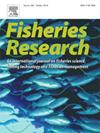What is an appropriate spatial scale for ecosystem based fishery management of kōura, spiny lobster Jasus edwardsii, in the Hauraki Gulf Marine Park, Aotearoa New Zealand?
IF 2.2
2区 农林科学
Q2 FISHERIES
引用次数: 0
Abstract
Ecosystem based fishery management (EBFM) remains an aspiration in Aotearoa New Zealand where single species fisheries assessments at large quota management area (QMA) spatial scales are standard. This review of the available information for the spiny lobster or kōura (Jasus edwardsii) in the Hauraki Gulf Marine Park (part of the CRA2 QMA) indicates that the present large scale fisheries assessment violates the modelling assumption of a unit stock because of smaller scale spatial patterns of puerulus settlement, juvenile and adult movement, abundance, ecological interactions, and fishing. While EBFM at the reef scale would be consistent with the limited movement of juvenile and adult kōura among adjacent reefs, high information requirements at this small scale demand a stepped transition from the QMA scale. Assessments of the CRA2 kōura stock based on six subregions would allow the identification of routes for population rebuilding in each sub-region and the development of EBFM of kōura at scales more relevant to its biology, ecology and fisheries as well as the communities with a stake in its sustainability. Management at these scales will require using existing fine-scale data where it exists and consideration of new ways to collect the required data at a suitable spatial scale to help fill the information gaps.
求助全文
约1分钟内获得全文
求助全文
来源期刊

Fisheries Research
农林科学-渔业
CiteScore
4.50
自引率
16.70%
发文量
294
审稿时长
15 weeks
期刊介绍:
This journal provides an international forum for the publication of papers in the areas of fisheries science, fishing technology, fisheries management and relevant socio-economics. The scope covers fisheries in salt, brackish and freshwater systems, and all aspects of associated ecology, environmental aspects of fisheries, and economics. Both theoretical and practical papers are acceptable, including laboratory and field experimental studies relevant to fisheries. Papers on the conservation of exploitable living resources are welcome. Review and Viewpoint articles are also published. As the specified areas inevitably impinge on and interrelate with each other, the approach of the journal is multidisciplinary, and authors are encouraged to emphasise the relevance of their own work to that of other disciplines. The journal is intended for fisheries scientists, biological oceanographers, gear technologists, economists, managers, administrators, policy makers and legislators.
 求助内容:
求助内容: 应助结果提醒方式:
应助结果提醒方式:


